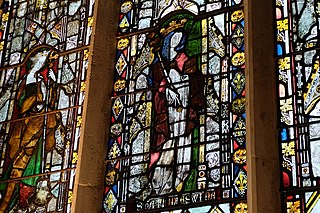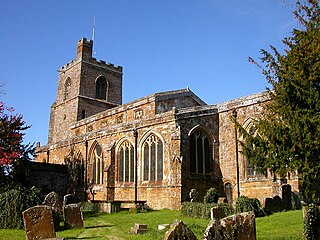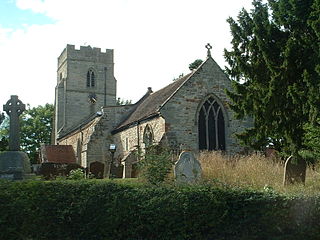Related Research Articles
Ælfheah, more commonly known today as Alphege, was an Anglo-Saxon Bishop of Winchester, later Archbishop of Canterbury. He became an anchorite before being elected abbot of Bath Abbey. His reputation for piety and sanctity led to his promotion to the episcopate and, eventually, to his becoming archbishop. Ælfheah furthered the cult of Dunstan and also encouraged learning. He was captured by Viking raiders in 1011 during the siege of Canterbury and killed by them the following year after refusing to allow himself to be ransomed. Ælfheah was canonised as a saint in 1078. Thomas Becket, a later Archbishop of Canterbury, prayed to him just before his own murder in Canterbury Cathedral in 1170.

Edmund of Abingdon was an English-born prelate who served as Archbishop of Canterbury. He became a respected lecturer in mathematics, dialectics and theology at the Universities of Paris and Oxford, promoting the study of Aristotle. Having already an unsought reputation as an ascetic, he was ordained a priest, took a doctorate in divinity and soon became known not only for his lectures on theology but as a popular preacher, spending long years travelling within England, and engaging in 1227 preaching the sixth crusade. Obliged to accept an appointment as Archbishop of Canterbury by Pope Gregory IX, he combined a gentle personal temperament with a strong public stature and severity towards King Henry III in defence of Magna Carta and in general of good civil and Church government and justice. He also worked for strict observance in monastic life and negotiated peace with Llywelyn the Great. His policies earned him hostility and jealousy from the king, and opposition from several monasteries and from the clergy of Canterbury Cathedral. He died in France at the beginning of a journey to Rome in 1240. He was canonised in 1246.

Offa was King of Mercia, a kingdom of Anglo-Saxon England, from 757 until his death. The son of Thingfrith and a descendant of Eowa, Offa came to the throne after a period of civil war following the assassination of Æthelbald. Offa defeated the other claimant, Beornred. In the early years of Offa's reign, it is likely that he consolidated his control of Midland peoples such as the Hwicce and the Magonsæte. Taking advantage of instability in the kingdom of Kent to establish himself as overlord, Offa also controlled Sussex by 771, though his authority did not remain unchallenged in either territory. In the 780s he extended Mercian Supremacy over most of southern England, allying with Beorhtric of Wessex, who married Offa's daughter Eadburh, and regained complete control of the southeast. He also became the overlord of East Anglia and had King Æthelberht II of East Anglia beheaded in 794, perhaps for rebelling against him.

Edward, often referred to by his epithet Edward the Martyr was King of the English from 975 until he was murdered in 978. Edward was the eldest son of King Edgar the Peaceful but was not his father's acknowledged heir. On Edgar's death, the leadership of England was contested, with some supporting Edward's claim to be king and others supporting his younger half-brother Æthelred the Unready, recognised as a legitimate son of Edgar. Edward was chosen as king and was crowned by his main clerical supporters, the archbishops Dunstan of Canterbury and Oswald of York.

Edgar, known as Edgar the Peaceful or Edgar the Peaceable, was King of the English from 959 until his death. He was the younger son of Edmund I and Ælfgifu of Shaftesbury, and came to the throne as a teenager, following the death of his older brother Eadwig. As king, Edgar further consolidated the political unity achieved by his predecessors, with his reign being noted for its relative stability. His most trusted advisor was Dunstan, whom he recalled from exile and made Archbishop of Canterbury. The pinnacle of Edgar's reign was his coronation at Bath in 973, which was organised by Dunstan and forms the basis for the current coronation ceremony. After his death he was succeeded by his son Edward, although the succession was disputed.

Coenwulf was the King of Mercia from December 796 until his death in 821. He was a descendant of a sibling of King Penda, who had ruled Mercia in the middle of the 7th century. He succeeded Ecgfrith, the son of Offa; Ecgfrith only reigned for five months, and Coenwulf ascended the throne in the same year that Offa died. In the early years of Coenwulf's reign he had to deal with a revolt in Kent, which had been under Offa's control. Eadberht Præn returned from exile in Francia to claim the Kentish throne, and Coenwulf was forced to wait for papal support before he could intervene. When Pope Leo III agreed to anathematise Eadberht, Coenwulf invaded and retook the kingdom; Eadberht was taken prisoner, was blinded, and had his hands cut off. Coenwulf also appears to have lost control of the kingdom of East Anglia during the early part of his reign, as an independent coinage appears under King Eadwald. Coenwulf's coinage reappears in 805, indicating that the kingdom was again under Mercian control. Several campaigns of Coenwulf's against the Welsh are recorded, but only one conflict with Northumbria, in 801, though it is likely that Coenwulf continued to support the opponents of the Northumbrian king Eardwulf.

Edmund the Martyr was king of East Anglia from about 855 until his death. Edmund's cult flourished in the Early and High Middle Ages, and he and Edward the Confessor were regarded as the patron saints of England until they were replaced by Saint George in the 15th century.

Oswine, Oswin or Osuine was a King of Deira in northern England.

Coenred was king of Mercia from 704 to 709. Mercia was an Anglo-Saxon kingdom in the English Midlands. He was a son of the Mercian king Wulfhere, whose brother Æthelred succeeded to the throne in 675 on Wulfhere's death. In 704, Æthelred abdicated in favour of Coenred to become a monk.

Frithuswith, commonly Frideswide, was an English princess and abbess. She is credited as the foundress of a monastery later incorporated into Christ Church, Oxford. She was the daughter of a sub-king of a Mercia named Dida of Eynsham whose lands occupied western Oxfordshire and the upper reaches of the River Thames.

Saint Winifred was a Welsh virgin martyr of the 7th century. Her story was celebrated as early as the 8th century, but became popular in England in the 12th, when her hagiography was first written down.

Cropredy is a village and civil parish on the River Cherwell, 4 miles (6.4 km) north of Banbury in Oxfordshire.

Æthelberht, also called Saint Ethelbert the King, was an eighth-century saint and a king of East Anglia, the Anglo-Saxon kingdom which today includes the English counties of Norfolk and Suffolk. Little is known of his reign, which may have begun in 779, according to later sources, and very few of the coins he issued have been discovered. It is known from the Anglo-Saxon Chronicle that he was killed on the orders of Offa of Mercia in 794.

Offchurch is a village and civil parish on the River Leam, 3 miles (4.8 km) east of Leamington Spa in Warwickshire. The population of the civil parish at the 2011 census was 250.

Ubba was a 9th-century Viking and one of the commanders of the Great Heathen Army that invaded Anglo-Saxon England in the 860s. The Great Army appears to have been a coalition of warbands drawn from Scandinavia, Ireland, the Irish Sea region and Continental Europe. There is reason to suspect that a proportion of the Viking forces specifically originated in Frisia, where some Viking commanders are known to have held fiefdoms on behalf of the Franks. Some sources describe Ubba as dux of the Frisians, which could be evidence that he also associated with a Frisian benefice.
Saint Edith of Polesworth is an obscure Anglo-Saxon abbess associated with Polesworth (Warwickshire) and Tamworth (Staffordshire) in Mercia. Her historical identity and floruit are uncertain. Some late sources make her a daughter of King Edward the Elder, while other sources claim she is the daughter of Egbert of Wessex. Her feast day is 15 July.
Saint Ælfgifu of Shaftesbury, also known as Saint Elgiva was the first wife of Edmund I, by whom she bore two future kings, Eadwig and Edgar. Like her mother Wynflaed, she had a close and special if unknown connection with the royal nunnery of Shaftesbury (Dorset), founded by King Alfred, where she was buried and soon revered as a saint. According to a pre-Conquest tradition from Winchester, her feast day is 18 May.
John of Tynemouth was a medieval English chronicler who flourished in the mid-14th-century.
The Beasts of battle is a poetic trope in Old English and Old Norse literature. It consists of the wolf, the raven, and the eagle, traditional animals accompanying the warriors to feast on the bodies of the slain. It occurs in eight Old English poems and in the Old Norse Poetic Edda.

The Church of Saint Mary the Virgin is the Church of England parish church of Bampton, West Oxfordshire. It is in the Archdeaconry of Dorchester in the Diocese of Oxford.
References
- ↑ John Blair, "Anglo Saxon Oxfordshire" (Alan Sutton Publications 1994).
- ↑ Descriptive Catalogue of Materials Relating to the History of Great Britain and Ireland: From 1066 A. D. to 1200 A. D, Sir T. D Hardy, Longman, Green, Longman, and Roberts, 1865
- 1 2 "The Parish of Dunstable: Who was St. Fremund?" . Retrieved 22 October 2009.
- 1 2 Anglo-Saxon Chronicle, ed. M. Swanton (Dent, London 1997), s.a. 911-918.
- ↑ Gesta Regum Anglorum, William of Malmsbury
- ↑ The Chronicle of Aethelwerd
- 1 2 3 A Forgotten Saint, Rev. Canon Wood, D.D., The Antiquary (Volume 27), Jan & Jun 1893
- 1 2 'Parishes: Cropredy', A History of the County of Oxford: Volume 10: Banbury hundred (1972), pp. 157-175. URL: Date accessed: 25 January 2012.
- ↑ "The Parish of Dunstable: History of St Fremund's Church, Dunstable" . Retrieved 22 October 2009.